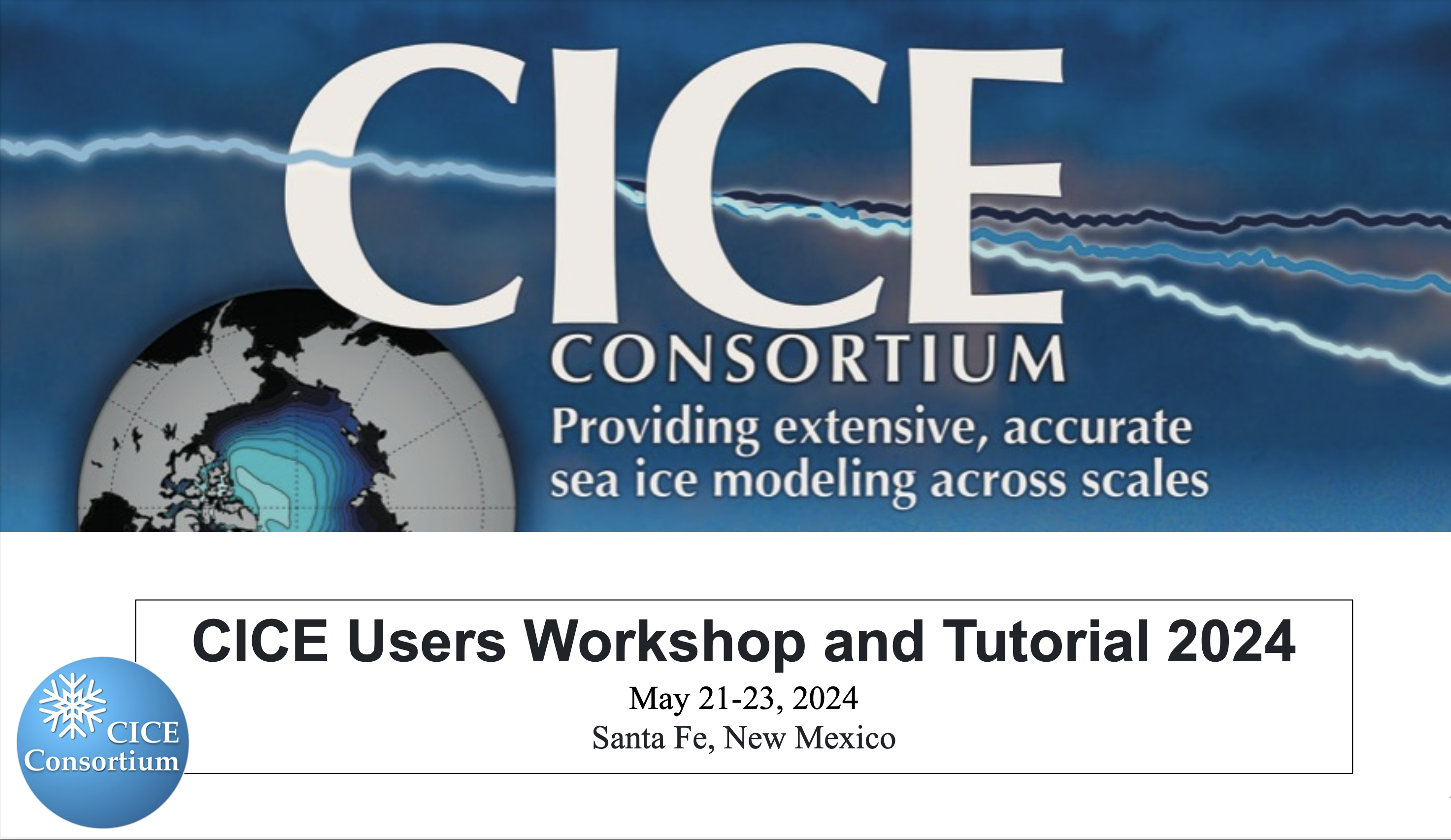Report from CICE Consortium Workshop (May 21-23)
CICE Users Workshop and Tutorial
Santa Fe, New Mexico, May 21-23, 2024
In 2016, a group of primary developers and users of a preeminent sea ice model, known as the Los Alamos Sea Ice Model (CICE), founded an eponymous consortium, whose mission is to foster collaboration on sea ice model developments for earth system research as well as operational applications.
The CICE Consortium team and community members recently gathered in Santa Fe, NM for a 3-day workshop and hands-on tutorial using Icepack, which forms the column physics package for CICE. The workshop attracted 38 in-person participants and 24 online registrants and was jointly funded by DOE/LANL, DoD/ONR, and NSF/NCAR. Wave-ice interactions and data integration/assimilation were the major science focus areas, although all aspects of the sea ice model were covered during the workshop, such as physics and biogeochemical modeling, software advances, and observational resources and needs. Slides for the talks are linked from the agenda.
A driving motivation for LANL hosting the workshop was to develop relationships with wave-ice experts around the world, in both field studies and modeling, to strengthen E3SM’s new development in this area. The scientists learned of a much-needed floe-size data product, which will now be shared. Other gaps identified for both modeling and observations include wave-induced ice breakup, wave attenuation in the sea ice pack and marginal ice zone, wave mixing and transport of frazil underneath sea ice floes, and frazil production by wave-induced friction between ice floes. The Wave-Ice Interactions session generated considerable interest in setting up a working group including both observational experts and modelers. A proposal to a Brown University center to support another workshop specific to this area was initiated during the CICE workshop and submitted shortly thereafter; joint proposals to other funding agencies are also an exciting possibility.
The Data Integration and Assimilation session featured three panelists with data assimilation expertise using CICE or other models (NOAA, Navy, CESM). The discussion was very enlightening as to the state of the art and current challenges. For instance, including sea ice state variables in data assimilation frameworks significantly improves predictions compared with those assimilating only ocean and atmosphere quantities. A particular challenge is differences in the definitions and scales of the quantities being assimilated and their model counterparts. Also, biased atmospheric model data quickly cause sea ice simulations to revert to their biased state prior to observed data assimilation. Workshop participants agreed that we don’t fully understand or account for the relationships between sea ice model variables and observed/measured quantities, or for observational biases and uncertainties. A challenge for modeling centers is that ice and ocean data assimilation frameworks are independent and therefore miss important interactions. A promising new direction is to assimilate sea ice tracers with impacts on the primary state variables (e.g. melt ponds for ice thickness). This idea was suggested during the 2020 CICE Workshop and is now a funded project. A new suggestion this year is to use data assimilation to understand tidal processes in polar regions.
Field work and lab experiments are steadily providing data for comparison with models, or for building new or improved parameterizations. For instance, field experiments using a ship to create waves that break up the ice have provided great insights into ice breakup and other ice-ocean coupling considerations, such as frazil ice physics. Lab experiments freezing microplastics into the ice have provided insight into biases of individual model process representations. The microplastics effort inspired our hands-on tutorial project, to install a new tracer in Icepack.
The workshop highlighted a number of additional modeling and observational gaps, such as:
- Spatial heterogeneity and sub-grid-scale features
- Melt ponds and lateral transport of meltwater
- Thermal conduction laterally and in ridges
- Full understanding of ice-ocean and ice-atmosphere coupling complexity and instabilities, including representation of frazil ice production in the ocean, brackish and freshwater ice-ocean coupling, and mismatched shortwave radiation bands in sea ice and atmosphere models
- Thermodynamics including thermal and hydrological effects of rain on sea ice, snow-ice, porosity of ridges and their effects on conduction, and gas as a third phase in sea ice
- Biogeochemistry
- Icebergs
- Regional model configurations and forcing (coupled and stand-alone)
- Advanced programming techniques (e.g. C++, computational efficiency).
We need observations now to understand preindustrial and multiyear ice, so that we can simulate it in the future when it is no longer available to measure.
Contact
- Elizabeth Hunke, Los Alamos National Laboratory
This article is a part of the E3SM “Floating Points” Newsletter, to read the full Newsletter check:



